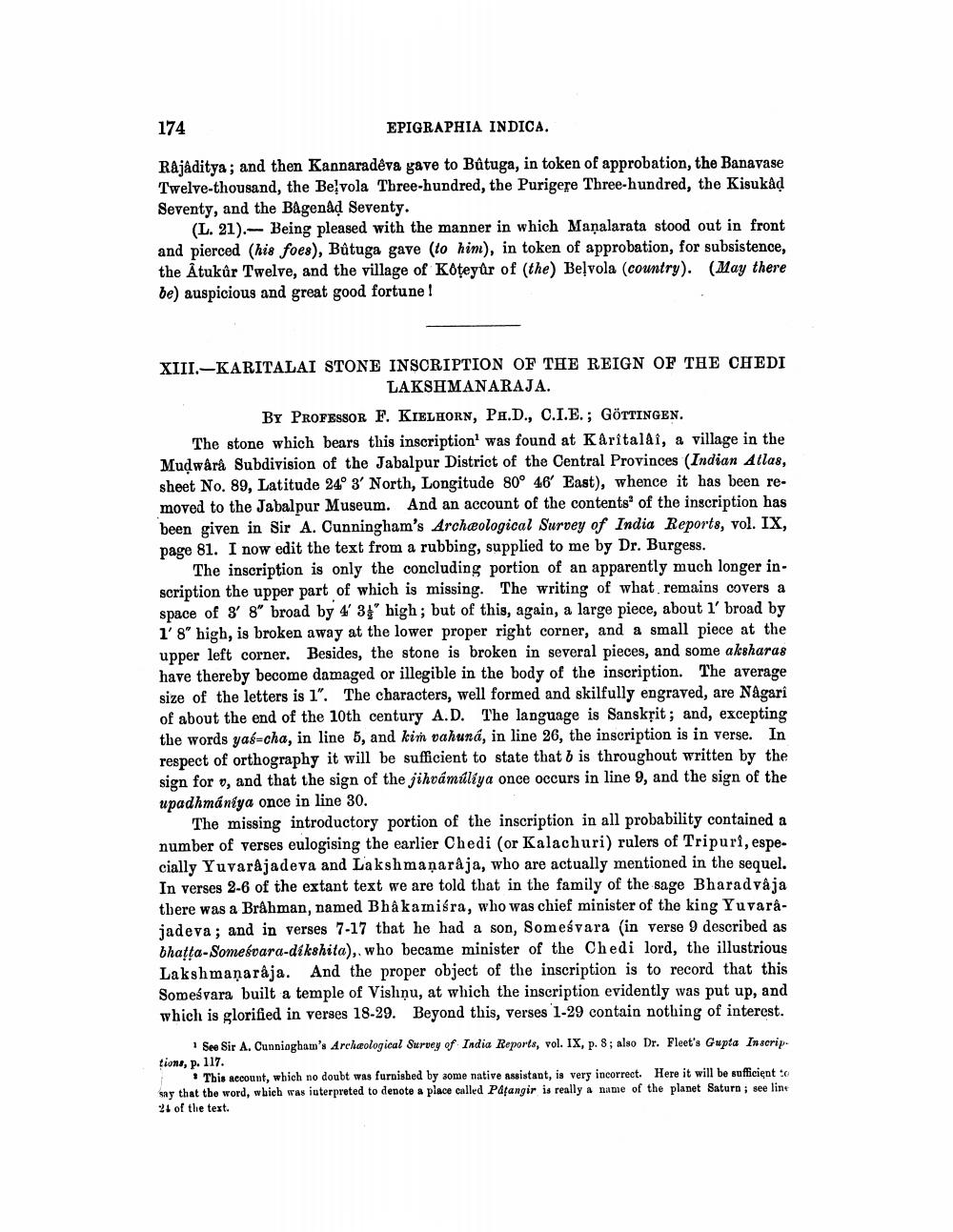________________
174
EPIGRAPHIA INDICA.
Rajaditya; and then Kannaradeva gave to Bûtuga, in token of approbation, the Banavase Twelve-thousand, the Belvola Three-hundred, the Purigere Three-hundred, the Kisukad Seventy, and the Bagenad Seventy.
(L. 21).- Being pleased with the manner in which Maņalarata stood out in front and pierced (his foes), Bůtuga gave (to him), in token of approbation, for subsistence, the Atukûr Twelve, and the village of Koteyûr of (the) Beļvola (country). May there be) auspicious and great good fortune!
XIII.-KARITALAI STONE INSCRIPTION OF THE REIGN OF THE CHEDI
LAKSHMANARAJA. BY PROFESSOR F. KIELHORN, PH.D., C.I.E.; GÖTTINGEN. The stone which bears this inscription' was found at Karitaldi, a village in the Mudwårå Subdivision of the Jabalpur District of the Central Provinces (Indian Atlas, sheet No. 89, Latitude 24° 3' North, Longitude 80° 46' East), whence it has been removed to the Jabalpur Museum. And an account of the contents of the inscription has been given in Sir A. Cunningham's Archeological Survey of India Reports, vol. IX, page 81. I now edit the text from a rubbing, supplied to me by Dr. Burgess.
The inscription is only the concluding portion of an apparently much longer inscription the upper part of which is missing. The writing of what remains covers a space of 3' 8" broad by 4' 31' bigh; but of this, again, a large piece, about l' broad by 1'8" high, is broken away at the lower proper right corner, and a small piece at the upper left corner. Besides, the stone is broken in several pieces, and some aksharas have thereby become damaged or illegible in the body of the inscription. The average size of the letters is 1". The characters, well formed and skilfully engraved, are Nagari of about the end of the 10th century A.D. The language is Sanskrit; and, excepting the words yas-cha, in line 5, and kim vahuná, in line 26, the inscription is in verse. In respect of orthography it will be sufficient to state that b is throughout written by the sign for y, and that the sign of the jihvámúliya once occurs in line 9, and the sign of the upadhmaniya once in line 30.
The missing introductory portion of the inscription in all probability contained a number of verses eulogising the earlier Chedi (or Kalachuri) rulers of Tripuri, especially YuvarAjadeva and Lakshmanaraja, who are actually mentioned in the sequel. In verses 2-6 of the extant text we are told that in the family of the sage Bharadvaja there was a Brahman, named Bhâ kamisra, who was chief minister of the king Yuvarajadeva; and in verses 7-17 that he had a son, Someśvara (in verse 9 described as bhatta-Somebvara-dikshita), who became minister of the Chedi lord, the illustrious Lakshmanaraja. And the proper object of the inscription is to record that this Someśvara built a temple of Vishnu, at which the inscription evidently was put up, and which is glorified in verses 18-29. Beyond this, verses 1-29 contain nothing of interest.
See Sir A. Cunningham's Archological Survey of India Reports, vol. IX, p. 8; also Dr. Fleet's Gupta Inscrip tions, p. 117.
This account, which no doubt was furnished by some native assistant, is very incorrect. Here it will be sufficient to say that the word, which was interpreted to denote a place called Pdfangir is really a name of the planet Saturn; see line 21 of the text.




